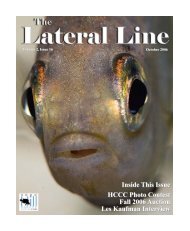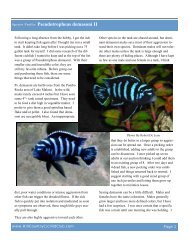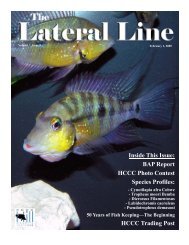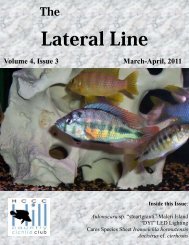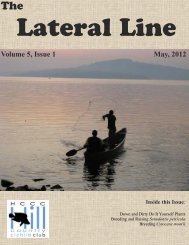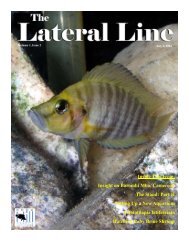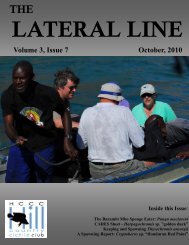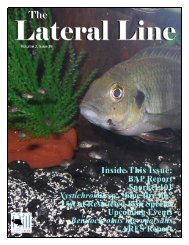December - Hill Country Cichlid Club
December - Hill Country Cichlid Club
December - Hill Country Cichlid Club
Create successful ePaper yourself
Turn your PDF publications into a flip-book with our unique Google optimized e-Paper software.
The<br />
Lateral Line<br />
Volume 5, Issue 4 <strong>December</strong>, 2012<br />
Inside this Issue:<br />
Keeping <strong>Cichlid</strong>s Outside Year Round—Ghetto Style!<br />
Iranocichla hormuzensis, Coad, 1982<br />
C.A.R.E.S. Yssichromis piceatus<br />
Spawning Corydoras Axelrodi...Sort of!
2<br />
The HCCC is a proud member of the<br />
Federation of Texas<br />
Aquarium Societies.<br />
The HCCC is a proud member of the<br />
Federation<br />
of American Aquarium<br />
Societies.<br />
On the Cover - Alcolapia alcalicus<br />
Editorial 3<br />
Keeping <strong>Cichlid</strong>s Outside Year Round—Ghetto Style! 8<br />
- Greg Steeves<br />
Iranocichla hormuzensis, Coad, 1982 12<br />
- Dave Hansen<br />
C.A.R.E.S. Yssichromis piceatus 18<br />
Spawning Corydoras axelrodi...Sort of! 19<br />
- Keith Arnold<br />
http://www.hillcountrycichlidclub.com/<br />
https://www.facebook.com/groups/hillcountrycichlidclub
3<br />
Editorial<br />
First off, to all HCCC members and other clubs that<br />
we exchange publications with, let me apologize for<br />
the lengthy lapse between Lateral Line issues. 2012<br />
has seen some changes in the club and 2013 is going<br />
to see even more. I feel the time of growing is<br />
fantastic for the longevity of our organization and<br />
I’m very confident that the future will bring only<br />
better changes to the <strong>Hill</strong> <strong>Country</strong> <strong>Cichlid</strong> <strong>Club</strong>.<br />
While from the outside looking in it might seem as<br />
though 2012 was not an active year for us and for<br />
some that might be true. For others, it was more<br />
than busy enough with club business. We held<br />
three successful auctions with a ton of new faces<br />
attending. We have actually changed some aspects<br />
of the auction including the methods of payment<br />
and greatly shortened the time that sellers receive<br />
payment. Diane Tennison has almost solely been<br />
responsible for revamping the system and deserves<br />
all the credit for our success in this area.<br />
Another hugely active area of involvement within<br />
our club has been the HCCC Facebook site. Our<br />
presence here has allowed us to reach a much larger<br />
audience as well as publicizing our existence to local<br />
hobbyists who had no idea there was a cichlid<br />
club here. If there is a dark side to the Facebook<br />
site is that it has become so active that it has actually<br />
taken away some of the activity that we traditionally<br />
seen on the HCCC message board. What I<br />
would like to see is someone step up and publicize<br />
informative posts received on Facebook to our<br />
HCCC forum and vice versa.<br />
I would like to recognize one of the pillars of our<br />
group, Dave Schumacher of Dave’s Rare Aquarium<br />
Fish for what he does. Dave borrowed a great idea<br />
that the East Coast <strong>Cichlid</strong> bunch do at their auctions.<br />
This was the catfish raffle. I was told this<br />
was well received and is something we want to incorporate<br />
into future auctions as well. Dave provided<br />
the fish for the raffle and together with his<br />
wife Amanda, secured our permanent location for<br />
club auctions. Starting in 2013 we will be holding<br />
our first ever Swap Meet here as well. I will make<br />
the information on this available just as soon as I<br />
can.<br />
Dave and Amanda have been searching for a location<br />
where we will permanently move our meetings<br />
to. The plan is to have an HCCC meeting every<br />
second month at the same day and time (ex. every<br />
second Saturday at 6pm). The meeting will include<br />
a BAP and members auction, a speaker that will<br />
present on a subject relevant to our members interest,<br />
and snacks for all. The plan is to turn our<br />
meetings into an event that anyone with even a<br />
passing interest in cichlids that lives in the area,<br />
would not want to miss. We were hoping to have a<br />
location locked in by now but we are still searching.<br />
Ideally we would like to find something on the<br />
Northside of San Antonio, Shertz, New Braunfels<br />
or San Marcos…..or anywhere in between. If you<br />
have an idea for a location or know of someplace<br />
we could frequent, please let us know. I fully expect<br />
that we will eventually need meeting space for<br />
100 people. The club is willing to pay for a location<br />
willing to house us but it must be reasonable.<br />
In speaking with Dan Schacht, our BAP Chairman,<br />
BAP entries have been slow in coming this year. I<br />
know by seeing some of the species that people<br />
have breeding on our Facebook site, that next year<br />
could be a record breaker.<br />
Troy Veltrop is not only our club CARES Chairman,<br />
but also the CARES Preservation website<br />
master. He has asked, told, beg and asked me again<br />
to update my CARES species and I am yet to do<br />
that. Some shining example I turned out to be! I<br />
will be doing that and sending my information in to<br />
him and I would urge those of you already registered<br />
to do that same. Those of you with CARES<br />
species that have not registered them should do so.<br />
You can reach Troy on the HCCC website. A listing<br />
of CARES fish can be found at http://<br />
www.carespreservation.com.<br />
On the CARES bandwagon, three HCCC members<br />
recently appeared on the Under The Sea Radio<br />
Show. These shows are all archived and can be listened<br />
to at your leisure anytime. All had both CA-<br />
RES and HCCC content. Artist/ Paleontologist/<br />
Aquarist Ken McKeighen painted three works and<br />
donated them to the CARES program. These beautiful<br />
paintings are in my procession right now. One<br />
will be auctioned at the North East Council of<br />
Aquarium Societies Convention in Cromwell CT.
4<br />
April 5th-7th.<br />
http://convention.northeastcouncil.org/<br />
The second will be auctioned off at the Greater Chicago<br />
<strong>Cichlid</strong> Classic on Memorial Day Weekend in<br />
Chicago. http://www.gcca.net/.<br />
The third will be auctioned off at the HCCC Spring<br />
Auction and stay tuned to the website<br />
http://www.hillcountrycichlidclub.com for information<br />
as soon as it is available. Here are the paintings<br />
generously donated by the artist. Each is<br />
signed and dated by Ken McKeighen.<br />
The organization responsible for commissioning<br />
Ken to do these amazing paintings was Mary and<br />
William Forrest of the Under the Sea Radio Show.<br />
Ken McKeighen
5<br />
September 28, 2012.<br />
Mr. Greg Steeves has been scheduled to be on the Under The Sea Radio Show to discuss<br />
the C.A.R.E.S. Preservation Program and what aquarium hobbyists should know about every<br />
species at risk that are involved in the aquarium hobby.<br />
http://underthesearadioprogram.yolasite.com/the-fine-art-of-cares-lake-victoria.php<br />
November 16, 2012.<br />
Caroline Estes will be by to talk about the Tropical Fish Industry and about the <strong>Cichlid</strong> Hobby. Caroline<br />
Estes is the former owner of Amazonia Aquariums from Austin Texas and will provide a unique<br />
view on the hobby today. Including raising money for projects that are related to the tropical fish<br />
keeping hobby.<br />
http://underthesearadioprogram.yolasite.com/cichlidae-discussion-caroline-estes.php<br />
November 30, 2012.<br />
The Under The Sea Radio Show is pleased to have Mr. Troy Veltrop be a guest on the show to discuss<br />
some of the very interesting species that hobbyists can help out in keeping with the C.A.R.E.S.<br />
Preservation Program while learning about the behavior of these wonderful cichlids of Lake Victoria.<br />
http://www.blogtalkradio.com/wm-aquaculture/2012/12/01/the-fine-art-of-breeding-lake-victoriacichlids<br />
January 11, 2013.<br />
C.A.R.E.S. Preservation Program generally is a program designed for aquarists to aid in the conservation<br />
of endangered and extinct species in the wild that usually can be kept in a home aquarium.<br />
The Under The Sea Radio Show and Mr. Ken McKeighen are pleased to be working with this organization<br />
and Mr. Klaus Steinhaus who is scheduled to be on this show is the C.A.R.E.S. club representative.<br />
http://www.blogtalkradio.com/wm-aquaculture/2013/01/12/cares-preservation-program--klaussteinhaus<br />
.
6<br />
<br />
5514 IH 35 S, New Braunfels, TX.<br />
This past year was full of great fish events for those<br />
of you so inclined to attend. Our sister clubs the<br />
Houston Aquarium Society and the Texas <strong>Cichlid</strong><br />
Association both held numerous auctions throughout<br />
the year. Also the TCA held a Swap that Lee<br />
Ann and I attended. It was a lot of fun and I can’t<br />
wait for the next one.<br />
The annual American <strong>Cichlid</strong> Association convention<br />
was in Indianapolis Indiana and by all accounts<br />
was a very good gathering. This year the ACA is in<br />
Denver Colorado. That’s driving distance! It is sure<br />
to be a great time. Bob Grauer is one of my best<br />
friends and also the convention chair. I know this<br />
will be a show you won’t want to miss.<br />
The TCA went way over the top with the FOTAS<br />
convention this year. What a great time! Next year<br />
we are all flocking to Houston, the sight of FOTAS<br />
2013.<br />
I want to remind everyone that a club is only as<br />
good as its membership. If you would like an active<br />
club, you have to be an active member. There are<br />
several of us who have been doing the same jobs in<br />
the HCCC for several years. There is always room<br />
for someone that wants to take a role in the operation<br />
and future of our club to do so. Don’t be afraid<br />
to ask.<br />
As we get ready to close the door on 2012 and jump<br />
head first into 2013, I encourage everyone to share<br />
your fish experiences with the rest of us. Write an<br />
article, tell a story, share some photo’s attend a<br />
show and auction. The only things fish people love<br />
more than their fish, is other fish people!
7<br />
Retail Store Hours: Tues-Sat 10am-7pm Sun 12pm-5pm CLOSED MONDAYS<br />
12315 Wetmore Rd. San Antonio, TX 78247<br />
(210)653-8880<br />
Leadership Group<br />
Evan Bowers<br />
Diane Tennison<br />
Greg Steeves<br />
Dave Schumacher<br />
Dan Schacht<br />
JB Edmundson<br />
Robert DeLeon<br />
Finances - Diane Tennison<br />
BAP - Dan Schacht<br />
CARES - Troy Veltrop<br />
Events - Dave Schumacher<br />
Lateral Line - Greg Steeves<br />
Membership - Diane Tennison<br />
Publication Exchange - Greg Steeves<br />
Raleigh Aquarium Society<br />
Brazos Valley Aquarium Society<br />
Chatham Kent Aquarium Society<br />
Houston Aquarium Society<br />
Texas <strong>Cichlid</strong> Association<br />
Oklahoma Aquarium Association<br />
Aquarium <strong>Club</strong> of Lancaster County<br />
Durham Region Aquarium Society<br />
North Jersey Aquarium Society<br />
Any clubs interested in exchanging with the <strong>Hill</strong><br />
<strong>Country</strong> <strong>Cichlid</strong> <strong>Club</strong>, contact Greg at<br />
gasteeves@gmail.com.
8<br />
Keeping <strong>Cichlid</strong>s Outside Year Round—Ghetto Style! - Greg Steeves<br />
After many years of fishkeeping, there comes a time<br />
when adding another tank is just not enough. For<br />
most serious hobbyists I know, the next step is generally<br />
a trip to see and/or collect fish in their natural<br />
habitat. We are truly fortunate here in South Texas<br />
to be able to easily do both. Many of my friends<br />
have gone to Mexico for cichlids and livebearers or<br />
on the Amazon for some exotics. There are even<br />
several friends that have gone to Africa to collect on<br />
the Great Lakes. I have not made those trips yet but<br />
they are in my bucket list. I always admired the<br />
large tank full of Malawians at the San Antonio Zoo<br />
and figured it it could be done there, why couldn’t I<br />
figure out how to keep these fish outside as well.<br />
After a little research it became apparent that the<br />
Zoo had access to better funding than I had. Still,<br />
where there’s a will there’s a way.<br />
The cichlid pond in all its glory.<br />
Now I have to admit that keeping tropical's out of<br />
doors was not a revolutionary idea in any way. My<br />
friend Jeff Johnson had been doing it for years. The<br />
difference is that Jeff had been using the vats he<br />
kept out of doors for growing fish in the warm<br />
weather. When the water turned cooler he either<br />
sold his stock or brought them inside. Jeff had<br />
given me great advice on a number of questions I<br />
had including the “growing” season. He, quite correctly,<br />
advised me that fish could be maintained outside<br />
safely from April 15th to October15th. During<br />
this time there are other potential problems to deal<br />
with such as oak and cedar pollen and animals.<br />
Geographically I had figured that we were close in<br />
latitude to Florida. This is where the majority of<br />
North American tropical fish farms are. There are<br />
only two big differences that we have to be con-
9<br />
cerned with. That is heat and cold. It gets way hotter<br />
and much cooler here than the subtropical climate<br />
of the Miami area. This however, I considered<br />
a drawback, not a game stopper.<br />
For the last six years we have kept fish in containers<br />
of some sort outside in the yearly time period Jeff<br />
had suggested. These containers amounted to old<br />
plexi-glass vats at first and then into kiddie pools. I<br />
had experimented with some home made filtration<br />
systems, some effective, some not so much. Three<br />
years ago my buddy JB gave me<br />
a large above ground pool. Immediately<br />
I realized that this was<br />
the going to be the framework<br />
for my conquering the year<br />
round outdoor cichlidarium!<br />
Thinking that I had pretty much everything figured<br />
out, we went on to have the hottest summer on record.<br />
If I remember it was nearly 100 days in a row<br />
of temperatures in excess of 100F. The pool water<br />
heated to a point that I could not cool it or turn it<br />
enough to keep a descent oxygen content in it. The<br />
fish did not do very well. I decided that the next<br />
piece of equipment that would be necessary was a<br />
pump capable of turning the water better than what I<br />
had set up. While searching for an additional pump<br />
I happened on a sand filter unit that had what I<br />
thought would be needed and extra filtration! This<br />
was external item number three.<br />
Initially I set the big 5500 gallon<br />
pool up, added the stock filter<br />
that came with it and let it run.<br />
Within a week the water was so<br />
green that I could not see anything.<br />
Extra piece of equipment<br />
number one, UV sterilizer to<br />
handle the green water. A small<br />
power hear ran water through the<br />
sterilizer rather than hooking it<br />
inline with the filter. I wasn’t<br />
sure the high water flow would<br />
be as effective as a slower flow<br />
through the UV. It took about<br />
two weeks but the UV Sterilizer<br />
did the trick and kept the water<br />
crystal clear.<br />
It was now time to add some fish. I can’t remember<br />
what species I added first but I do remember that<br />
shortly after the fish went in, the oak trees that surround<br />
our property, started shedding oak pollen<br />
pods. When they inevitably hit the pond, the water<br />
immediately turned a crappy tea colored and again I<br />
could not see what was in the water. After the pollen<br />
fall had ended, I was able to drain the pond and<br />
basically start over. Needed item number two:<br />
some sort of cover to keep the pollen pods from the<br />
water.<br />
The sand filter unit replaced the original stock pump and filter unit.<br />
One other design flaw was that in the summer heat,<br />
the sides of the pond generated a great deal of heat<br />
and in the winter, there was nothing to insulate the<br />
water from the chill of the air. We added silver insulation<br />
commonly found in fish crates and used in<br />
shipping as well. We pieced these together with<br />
duct tape. While not ascetically pleasing, it turned<br />
out to be very effective for both purposes.<br />
We ordered a “solar blanket” to keep foreign objects<br />
out of the water and as an added bonus, it converts<br />
the suns rays into heat. It is very noticeable<br />
when the weather is cooler. The top comes off after<br />
the April pollen fall and will go on with the onset of<br />
cooler weather around November. On warmer winter<br />
days I don’t remove it but I do peel it back.
10<br />
The fourth and final piece of equipment was a pond<br />
heater that I found by accident. It only engages on<br />
very cool nights. Since installing all the extras, and<br />
despite a continued night time temperature in the<br />
20’sF the lowest the water temperature has gotten<br />
is 66F; quite acceptable for the fish I keep. Even in<br />
the heat of summer, the fish have done just fine.<br />
This floater supports the heating unit and keeps it<br />
off of the bottom. You can see the underside of the<br />
solar blanket that has been peeled away to show a<br />
large group of Pseudotropheus saulosi.<br />
Equipment list: Intex Above ground pool. 16’<br />
diamenter, roughly 5500 gallons.<br />
Speciality Pool Products So<br />
lar Blanket. Free floating<br />
cover.<br />
25 Watt UV Sterilizer com<br />
bined with a 500 gph power<br />
head.<br />
Clepco 1500 w pond heater.<br />
The thermostat and pond heating unit.<br />
We added several trays containing pool filter sand<br />
and planted with a native species collected locally.<br />
These plants have absolutely exploded! They look<br />
lush and green. As an added bonus, the mbuna<br />
don’t bother them at all.<br />
In the very middle of the pond is a reef built up<br />
mostly of holey rock that I have bought at club auctions<br />
and were too large for my tanks. The fish love<br />
this and this area is always full of newborn fry who<br />
use the holes in the rock as a refuge. I should mention<br />
that I added slate tiles to the middle portion of<br />
the pond so that the holey rock would not puncture<br />
the lining.<br />
The inhabitants of the pond are all cichlids from<br />
Lake Malawi and haplochromines from the Lake<br />
Victoria region. There are also several paradise fish<br />
(Macropodus opercularis) that were popped in there<br />
after spawning in one of our smaller ponds. These<br />
fish were either housed here previously, picked up<br />
at auction or given to me (primarily from Troy Veltrop,<br />
Nick Andreola and Dave Schumacher). All<br />
the fish have grown with most now reproducing. I<br />
had a lot of help from Dave Schumacher assisting<br />
with adding species that were not likely to hybridize.<br />
The fish both act differently than behaviors I<br />
have observed in the aquarium. Aggressive species<br />
coexist with other more docile species in the larger<br />
body of water.
11<br />
Perhaps the most enjoyable part of our pond experiment<br />
is being able to jump in and snorkel with the<br />
fish. It’s a lot of fun to hand feed them however, as<br />
they have gotten use to Lee Ann and I in the water<br />
and associate us with feeding, they have lost their<br />
fear of people. This has resulted in us being bitten.<br />
The two species that are the worst are Psuedotropheus<br />
saulosi and Astatotilapia latisfasciata. Feed<br />
in excess before jumping in the water!<br />
Species list:<br />
Astatotilapia latisfasciata<br />
Cynotilapia aurifrons<br />
Cyrtocara moorii<br />
Gephyrochromis moorii<br />
Labidochromis caeruleus<br />
Macropodus opercularis<br />
Paralabidochromis chromogynos<br />
Paralabidochromis sauvagei<br />
Pseudotropheus acei “white tail”<br />
Pseudotropheus flavus<br />
Pseudotropheus lombaordi<br />
Pseudotropheus saulosi<br />
Pundamilia nyererei<br />
Pundamilia sp. “red head”<br />
Copadichromis sp. "Kawanga no<br />
spot"<br />
Metriaclima sp. “elongates Chailosi”
12<br />
Iranocichla hormuzensis, Coad, 1982 - Dave Hansen<br />
Many aquatic hobbyists pursue rare fish. Scarcity<br />
in the hobby however, does not necessarily translate<br />
into a species being difficult or interesting to maintain.<br />
I am fortunate to possess a group of the uncommon<br />
and fascinating cichlid Iranocichla hormuzensis.<br />
The first challenge is undoubtedly locating<br />
this fish. Once you have found I. hormuzensis,<br />
breeding can be a daunting chore. I will explain the<br />
obstacles I have encountered during this article.<br />
Iranocichla hormuzensis is the only cichlid found in<br />
Iran and is the lone member of the genus<br />
(monotypical). It is a maternal mouthbrooder with<br />
an extremely limited range along the southern coast<br />
of Iran being restricted to rivers draining into the<br />
Strait of Hormuz. The word “river” can be misleading<br />
as I have seen pictures of this species being collected<br />
in ankle deep water flowing at a snail’s pace.<br />
Every waterway seems to be slightly different, ranging<br />
in width from 1-50 meters. Often the streams<br />
will experience diminished flow rates and will settle<br />
into pools. Some years the pools may have fish<br />
and others they do not. The parameters of the water<br />
of its habitat vary wildly in regards to both salinity<br />
and temperature. This is a large portion of the challenge<br />
in keeping these animals. Normally when I<br />
learn a fish comes from a system of fluctuating<br />
measurements, I associate it with a species that is<br />
easy to keep and a little bit more tolerant of the wa-
13<br />
ter when what we put into their tanks isn't perfect.<br />
The challenge is not in the daily maintenance of I.<br />
hormuzensis , but in matching those conditions<br />
when trying to induce spawning. These waterways<br />
have not been studied as extensively as most leaving<br />
many gaps in regards to addressing their water<br />
quality needs. A large portion of the terrain in<br />
close proximity to these rivers, consist of salt<br />
domes. This can cause to the water to be highly saline.<br />
Consequently, any influx of freshwater into<br />
the system will cause the salinity level to fluctuate.<br />
These are mostly small bodies of water and I would<br />
consider the conditions to be anything but stable. In<br />
addition, the water found in several oasis where this<br />
fish is found, consists of pure fresh water.<br />
If challenging water conditions were not enough,<br />
the area is exposed to extreme temperature changes.<br />
Winter temperatures range from 12-30 C while in<br />
summer this environment can swell up to 44+ C.<br />
Unlike many of the waterways associated with other<br />
cichlids, there is very little vegetation along the<br />
banks to provide any shade. This combined with<br />
the reduced water levels in the summer make for<br />
tough living.<br />
I have had discussions concerning the state of the<br />
fish in its native waterways with several people, including<br />
several prominent ichthyologists. Some<br />
think the fish is in serious peril because farmers are<br />
using the water for irrigation and industrialization of<br />
the region. The other camp maintains that the fish<br />
is not at any greater risk than they previously faced<br />
based on limited distribution and tough environmental<br />
conditions. The thought process is that the<br />
region is so undesirable and desolate that it has escaped<br />
the industrialization found elsewhere. Without<br />
treatment, the water is too salty to be used for<br />
farming. I have not heard much middle ground and<br />
the opinions seem to be far apart.<br />
This is an absolutely stunning fish when it matures.<br />
I. hormuzensis is relatively small at a maximum<br />
length of about 4”. While somewhat undersized, it<br />
processes a very stout body. Juveniles are slightly<br />
elongated and one can clearly see the convex shape<br />
of the head developing early on. At this point, any<br />
hints of future coloration are non existent. The<br />
young maintain a silver-green coloration with no<br />
pigmentation in the fins. The body exhibits 7- 11<br />
vertical bars that become less obvious as the fish<br />
matures. The dorsal fin contains an easily recognizable<br />
tilapia spot. In the description of the species, it<br />
is stated that males can be differentiated from females<br />
by a greater head length, larger pelvic fins,<br />
and greater interorbital width, but frankly I was unable<br />
to accurately sex these fish until they began to<br />
display certain behavior and color changes. When<br />
looking closely, you begin to notice white spots on<br />
the silver fish. Slowly the male begins to exhibit<br />
darkening shades of gray until it appears as a light<br />
black. When in breeding dress, the male is intensely<br />
black with white and turquoise iridescent<br />
spots scattered throughout the body and caudal fin.<br />
There are no spots on either the anal or pelvic fins.<br />
The dorsal contains some spots, and has white banding<br />
that occurs in the otherwise black fin. The<br />
speckling on the body begins behind the gill plate<br />
while the cranial region is black. If you look at<br />
other images and read through the limited material<br />
available, you will find that males also appear with<br />
a black body and a brick-red lower side along with<br />
the bottom portion of the jaw. The species description<br />
mentions both of these variants without further<br />
elaboration on potential reasons for the differences.<br />
It could be diet, water condition, or locale variants,<br />
but all of this is simply speculation on my part.<br />
Hopefully as additional taxonomic work is done<br />
with this cichlid we can fill some of the gaps in our<br />
knowledge. The females maintain the silver coloration<br />
and vertical barring. I have seen them darken<br />
up a little bit, but it is just very light gray without all<br />
the spotting. Unlike the males, the tilapia spot is<br />
easily seen in the females. The differentiation in<br />
hues of the females to a strutting male makes for a<br />
stunning display.
14<br />
I acquired my “group” of fish in November 2007. I<br />
say group, but it was only four individuals. This is<br />
a species I had been chasing for a number of years<br />
and was always near the top of my “must have” list.<br />
I was appreciative to obtain them, but will admit<br />
only having four individuals made me feel a little<br />
nervous. I was unsure of how to maintain them so<br />
this really didn’t give me very much room for error.<br />
The fish had just been released from the mother<br />
about 7 days previous to them coming into my possession<br />
and were extremely tiny. When I first gazed<br />
into the bag I couldn’t even see the fry at all. I<br />
poured the contents of the bag into a coffee cup<br />
hoping it would be easier to see them. I made out 4<br />
sets of tiny black eyes and breathed a sigh of relief.<br />
I am not a scientist and the idea of playing chemist<br />
with water parameters had me a bit anxious. The<br />
key factor I was trying to determine was the salt<br />
content of the water. I had a couple of weeks to<br />
prep and enrolled the help of my fellow fish geek,<br />
Nick Andreola, to figure out how I was going to set<br />
the tank up. The actual physical setup was easy. I<br />
prepared a 113 liter long as I would for any other<br />
cichlid I had maintained. I used a slightly oversized<br />
hang on the back filter and because I knew the fish<br />
were small I used a sponge over the intake tube to<br />
keep from siphoning them up into it. I employed<br />
pool filter sand as the substrate and dotted it with<br />
several medium size pieces of holey rock and tied in<br />
some artificial silk plants. These fish are accustomed<br />
to warm water, so I submerged a heater into<br />
the tank and set the thermostat for 23C. I filled the<br />
tank with water and looked at the volume of water<br />
and said to myself, “now what?” I had done as<br />
much research as possible on the specific waterways<br />
these fish were found and as I mentioned earlier it<br />
varies wildly. Even if I had exact readings, I had no<br />
idea how that would actually be executed in the<br />
tank. Nick was on the case though. I had total confidence<br />
he would figure this out for me. He called<br />
me to discuss and after listening to him explain in<br />
great detail; I had no idea what he was talking<br />
about. I don’t think Stephen Hawking would know<br />
what he was talking about! He had a mouthful of<br />
equations and numbers and you need this measuring<br />
device and oh by the way do you have access to an<br />
electron smasher? Maybe I added the last part, but<br />
this was giving me a headache. If these fish can’t<br />
survive in my tank how in the heck will they avoid<br />
disappearing in the wild? I hung up with Nick and<br />
told him I would call him later after I absorbed his<br />
information. Hopefully he isn’t still sitting by the<br />
phone. It took a little longer than it should have, but<br />
I decided to reach out to the few other hobbyists I<br />
knew of, who had kept them to uncover their maintenance<br />
secretes. I asked three people and got three<br />
different answers. One of them kept them in pure<br />
freshwater, another said a large soup spoon of salt<br />
per gallon, and the other said a small palm worth<br />
per gallon. Great, what are your local tap water<br />
conditions, what size are the soup spoons in Europe,<br />
and how big are your hands? After fretting over<br />
this for a couple of weeks I decide I will use a soup<br />
spoon worth of salt per gallon. I went to grab a<br />
spoon from the drawer and my wife asked what I<br />
was doing. I went into great detail to demonstrate<br />
how smart I was and I was using this spoon to salt<br />
the tank. “You are not using one of my nice spoons<br />
for your tanks” was her reply. She handed me a tablespoon<br />
from an old cutlery set and said I could<br />
have that one. So after weeks of research and discussion<br />
I am using a tablespoon per gallon of salt.
15<br />
I had the tank prepared for a week before I received<br />
the fish. Once they were in my hands I slowly acclimated<br />
them to their home. I was in my constantly,<br />
checking on, and trying to count the four of<br />
them. I was never able to get above three and lost<br />
the one very early on. This kicked my stress level<br />
up a notch.<br />
The fish has an elongated intestinal tract consistence<br />
with an algae based diet (Lamboj, pers<br />
comm.). I fed crushed spirulina flake for quite<br />
sometime. Growth was slow, but they were growing.<br />
This was a positive sign. Of course during this<br />
point it came time to do my first water change. I<br />
drained about 30% of the tank into a bucket and<br />
then poured the bucket into a gallon milk jug to precisely<br />
measure how much water I had taken out of<br />
the tank. I was determined to replace the salt content<br />
grain for grain. Half the water ended up on the<br />
floor as I was pouring it into the milk jugs. I. hormuzensis<br />
was my first foray into any type of fishkeeping<br />
involving salt and it wasn’t going well. I<br />
have had prouder moments in the hobby than this<br />
disaster in the making. Water was seeping all over<br />
the floor and I had no idea how much salt to replenish.<br />
Keep in mind how difficult the conditions are<br />
that these fish exist in the wild and this makes all of<br />
this obsessing bordering on silly. I was living in the<br />
moment though and determined to do this right. In<br />
hindsight I am sure a little less/more salt wouldn’t<br />
have bothered them much. I now use guesstimation<br />
and mix some salt and water into a bucket to fill the<br />
tank back up. I mixed it well and proceeded to siphon<br />
the water into the tank from the bucket. The<br />
bucket was empty. I looked in the pail and 90% of<br />
the salt had stayed in the bottom of the bucket. I<br />
walked over and shut the door to the fishroom. I<br />
didn’t need my family witnessing this spectacle. I<br />
grabbed the hose and went about filling the tank<br />
back up. I reached for the spoon, estimated what I<br />
needed to get close, and called it good. I attentively<br />
watched the fish for the next couple of hours<br />
waiting for them to keel over from the shock to their<br />
system they must surly have been experiencing.<br />
Amazingly they survived their first water change.<br />
Subsequent water changes went much smoother. I<br />
operated under the motto, “What doesn’t kill them<br />
only makes them stronger”. I drained the water,<br />
added dechlor, and slowly filled the water up and<br />
added salt as I was filling and it worked fine. As I<br />
discovered while tinkering with water parameters,<br />
these fish are extremely hardy.<br />
I had no false illusions that this trio would be breeding<br />
anytime soon. The dialogue I had developed<br />
with the other hobbyists, keeping I. hormuzensis<br />
was a wonderful source of information. It would be<br />
around 24 months before I could expect them to<br />
breed. I was concentrating on maintaining healthy<br />
fish while focused on water changes and feeding.<br />
Three fish in a 113 liter tank was not taxing the filtration<br />
system at all, but I performed a rigorous<br />
schedule of 30% weekly water changes. In addition<br />
to the spirulina flake I introduced algae tabs and the<br />
occasional protein flake which were greedily consumed.<br />
The fish were putting on size and aggression<br />
was not yet an issue. Despite no dithers or target<br />
fish in the aquarium they were not a shy species<br />
Fish Hobby Supply<br />
http://africancichlids.net/fhs/
16<br />
at all. I enjoyed watching them slowly develop.<br />
After a year, one of the individuals began transforming<br />
from silver to a light gray. Over a few<br />
months the coloration became a darker and darker<br />
gray until eventually the body was light black. The<br />
speckling became a bit more prominent during this<br />
time frame as well. There were still no signs of real<br />
aggression but this developing male had one side of<br />
the tank to himself and the other two tended to keep<br />
to the other side. All three would move freely without<br />
any aggression issues, but the tendency of the<br />
group was to stay on their own sides. The male was<br />
really coming into his own in regards to his coloration<br />
and was now in full bloom. This did not translate<br />
into any courting behavior though. Several<br />
months went by and the other two fish were starting<br />
to spar somewhat. As time drew on, a full out battle<br />
between the two females ensued. The two females<br />
spent several weeks rushing at each other and jaw<br />
locking. I was observing this closely as I could not<br />
afford to lose any of the fish. Despite the battle<br />
royal no visible damage was being done to either<br />
fish. Eventually this activity subsided and one of<br />
the females was now hanging out with the male in<br />
his rock pile. By no means were they exhibiting<br />
pairing behavior, but were definitely getting along<br />
enough to allow each other in the same area. The<br />
other fish stayed in her half of the tank. I have not<br />
seen any fighting between those two since that one<br />
frenzied period. The male was now in breeding coloration<br />
at all times and could be seen displaying to<br />
the female often. He would sashay across the tank<br />
and court the other female as well. This went on for<br />
several weeks before I actually witnessed a female<br />
with buccal cavity full of eggs. Over several<br />
months I had a female holding three times and never<br />
more than a week. The next time it happened I decided<br />
I would strip the eggs and tumble them. Unfortunately<br />
there has not been a next time. While<br />
the male has maintained his vibrant hues and occasionally<br />
shimmies up to a female, there has been<br />
almost zero courting behavior.<br />
More time passes I determine it is time to start tinkering<br />
with some water parameters to see if I can<br />
trigger a spawning. The nervousness I exhibited a<br />
couple of years ago is now gone and I am not too<br />
concerned about playing mad scientist. Many fish<br />
will spawn during a rainy season because they have<br />
learned that along with the rain come enhanced food<br />
sources. The first thing I do is to slowly lower the<br />
salt content in the tank. Once lowered, I would<br />
maintain it for at least a month. By the time I have<br />
tweaked it down as far as I felt comfortable with;<br />
the salt levels were about 25% of the original quantity.<br />
This wasn’t working. Next I varied the diet<br />
and begin feeding mosquito larvae I was collecting<br />
in a bucket outside. I also increased the frequency<br />
of the protein flake. With little effect, I tried a different<br />
brand of food, again, with no luck. The next<br />
factor to alter was temperature. I began by lowering<br />
the temperature of the heater and eventually turned<br />
it off. The lowest temperature the water reached<br />
was about 18C. I also proceeded to alter the salt<br />
content again as I was experimenting with the temperature.<br />
Once this failed to trigger any responses I<br />
began to crank the temperature up and had the<br />
heater up to 31C before deciding not to go any<br />
higher. I will admit while I was frustrated it was an<br />
enjoyable challenge as well. These fish were making<br />
me work to entice a spawning and I was having<br />
fun trying to outsmart them. After many months of<br />
this I still had nothing as far as spawns, but still had<br />
3 healthy fish that appeared no worse for wear.<br />
I reached out to a friend who wasn’t having any<br />
luck and he was able to pass along 4 females from<br />
his group all in the name of getting this species to<br />
breed. While there has been increased courting behavior<br />
only one spawn has been witnessed and it
17<br />
was aborted several days later. The shifting of parameters<br />
has resumed and different variations are<br />
being attempted. I have a friend who has proven he<br />
can spawn almost anything. He lives close by and<br />
we have moved the fish over to his house so he is<br />
working with them as well. It is more important to<br />
me to achieve a spawn and be able to share these<br />
fish than it is to keep them in my fishroom just for<br />
the sake of having them.<br />
The slightly alarming sequel to my story is that<br />
most of the other known groups in captivity have<br />
stopped spawning and no one is producing any fry.<br />
Iranocichla hormuzensis has been the most challenging<br />
fish I have kept to date and I am as enthusiastic<br />
today about them as I was when I was lucky<br />
enough to obtain them. It is an absolutely stunning<br />
fish that would be the highlight of any collection. I<br />
hope the attempts to spawn this fish are successful<br />
and more people will get the opportunity to enjoy<br />
them. This will only lead to more awareness of a<br />
beautiful cichlid and assist in expanding our knowledge<br />
base.
19<br />
Spawning Corydoras Axelrodi….Sort Of! - Keith Arnold<br />
Over a decade ago, I purchased two groups of corys.<br />
One was sold to me as Corydoras axelrodi, while<br />
the second group was sold as C. “deckeri”. I later<br />
learned that “deckeri” is a nomen nudum used for<br />
loxozonus. [The term, nomen nudum, refers to a<br />
scientific name which has never been formally described,<br />
hence has no standing]. I could not distinguish<br />
between the two groups, so I wrote to a wellknown<br />
catfish expert for his input: he never replied.<br />
Since I couldn’t tell the two groups apart, I decided<br />
they were the same species and placed them in a 10-<br />
gallon tank, where they have been ever since.<br />
According to David Sands (1983. Catfishes of the<br />
World, Vol. 1, p. 88a. Dunure Enterprises, Dunure,<br />
Scotland) C. axelrodi lacks the lateral body coloration<br />
of C. loxozons. However, Burgess (1992. Colored<br />
Atlas of Miniature Catfish. T.F.H. Publications,<br />
Inc., Neptune, New Jersey) notes that C. loxozons<br />
has an anterior dark bar on the dorsal fin which<br />
joins the strong lateral line; the latter runs onto the<br />
lower portion of the caudal fin. C. axelrodi lacks<br />
both of these characters as do my fish. Both species<br />
come from the Meta district of Colombia. Sands<br />
(op. cit) cites Rio Meta as the origin of C. axelrodi,<br />
and the Rio Ariari, a tributary of the Rio Guaviare,<br />
as the source of C. loxozonus. It may be that both<br />
occur in the same river drainages, thus leading to<br />
the high similarity in color pattern or the two species<br />
may have evolved from the same ancestor in<br />
which different populations were “captured” with<br />
separation of river drainages. Sands (1984. Supplement<br />
1, p.48b) lists 20 species of Corydoras which<br />
have either a mimic or species with a similar color<br />
pattern; mimics usually occur in the same rivers,<br />
those with similar patterns may or may not inhabit<br />
the same river.<br />
Despite heavy water changes, rich foods and strong<br />
aeration, I never saw any spawning activity. In the
20<br />
meantime, Java moss in the tank prospered as did a<br />
type of slimy alga.<br />
On November 3rd, in preparation for the 2011 FO-<br />
TAS convention, I removed about one-half of the<br />
Java moss, intending to place this in the FOTAS<br />
auction. On November 7th, while feeding my fish, I<br />
thought I saw a small cory in the axelrodi tank, but I<br />
couldn’t be sure. The next day I saw at least two<br />
small corys around an inch in length. So, on November<br />
19th, I removed all of the Java moss,<br />
drained about 60 per cent of the water and replaced<br />
it, and placed a HOT magnum on the tank. After<br />
about 30 minutes, as the water cleared, I began to<br />
see three, four, six. young corys one inch in length<br />
or less. At this time I have conservatively estimated<br />
12-15 young corys, probably from two or more<br />
spawnings, based on size differences.<br />
In seems obvious to me, that as these corys spawned<br />
– probably IN the Java moss – the dense nature of<br />
the Java moss served both as a refuge for the fry as<br />
well as an excellent source of food. Now, I am anxious<br />
to discern just how many young C. axelrodi are<br />
in the tank.<br />
The great items up for grabs at the HCCC Fall Auction Catfish Raffle.
The Lateral Line is the official publication of the <strong>Hill</strong><br />
<strong>Country</strong> <strong>Cichlid</strong> <strong>Club</strong>. Reprinting freely permitted to<br />
non commercial organizations.<br />
21



